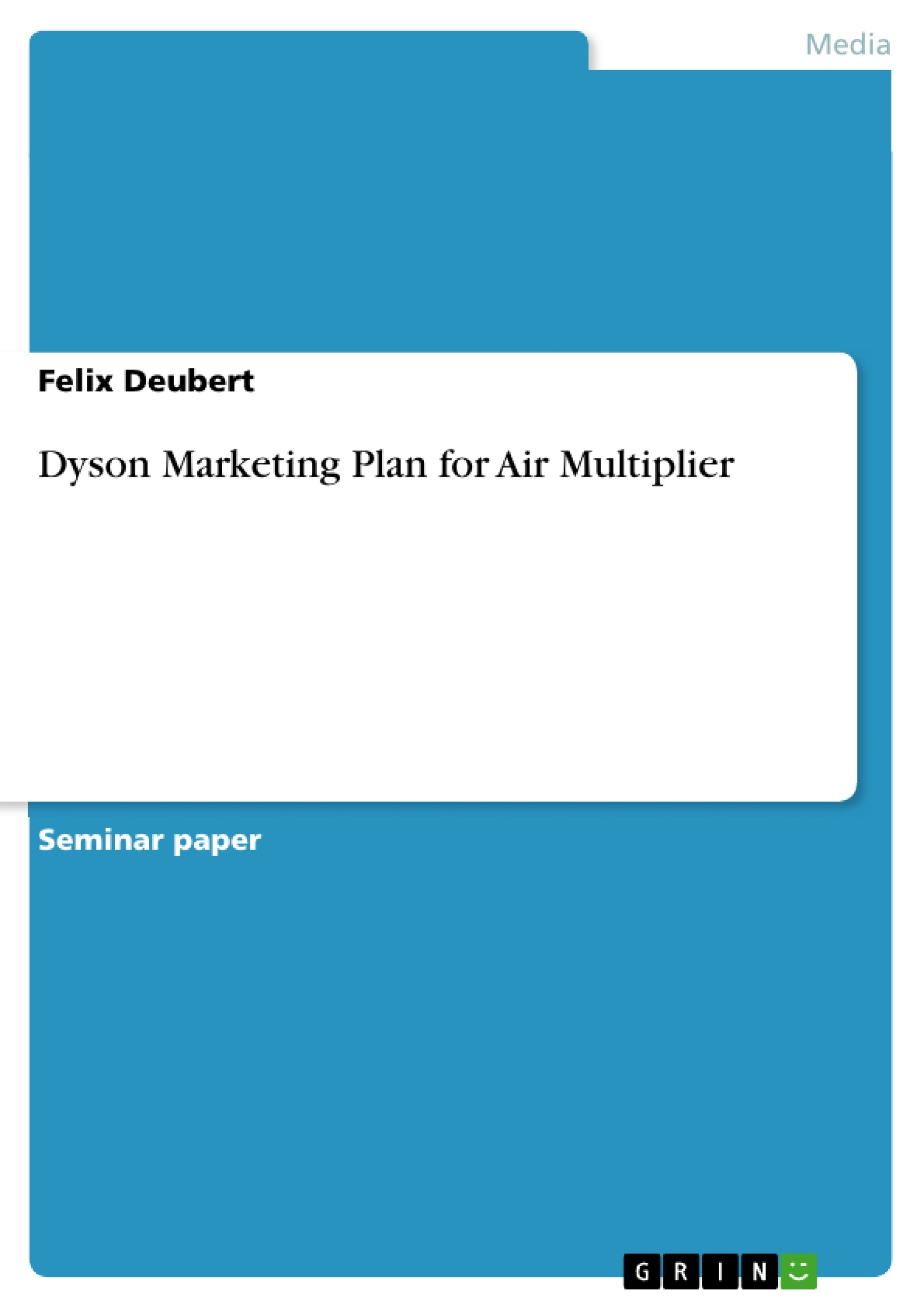With the Dyson Air Multiplier we will offer every individual the possibility to create his or her perfect environment, whether at home or at work, without needing to be either considerate of or dependent on the preferences of others.
At Dyson, we embrace the individuality of every man by endorsing the opportunity for individualism in a space that is so important to the well‐being of everyone, but has been dominated by compromise among many.
Table of Contents
- 1. Marketing Planning
- 1.1 Business Mission and Objectives
- 1.1.1 Mission Statement
- 1.2 Situational Analysis
- 1.2.1 Strengths
- 1.2.2 Weaknesses
- 1.2.3 Opportunities
- 1.2.4 Threats
- 2. Marketing Strategy
- 2.1 Segmentation
Objectives and Key Themes
The objective of this marketing plan is to outline a strategy for launching the Dyson Air Multiplier in the German market. The plan analyzes the product's strengths, weaknesses, opportunities, and threats (SWOT), identifies target consumer segments, and proposes a marketing approach leveraging Dyson's brand strength and the product's unique features. The plan focuses on positioning the Air Multiplier as a premium, innovative solution for creating a personalized climate environment.
- Creating a personalized climate control experience.
- Leveraging Dyson's brand reputation for innovation and quality.
- Targeting premium consumers in the German market.
- Analyzing the competitive landscape and identifying opportunities within a "blue ocean" market.
- Mitigating potential risks associated with introducing a new product category.
Chapter Summaries
1. Marketing Planning: This chapter lays the groundwork for the marketing plan by establishing the Dyson Air Multiplier's mission and objectives. The mission statement emphasizes providing individuals with the ability to create their ideal climate, highlighting the product's focus on personalized comfort and independence from shared environmental settings. A detailed SWOT analysis follows, examining Dyson's brand strength, technological advancements, and the potential challenges of entering a new market segment. Strengths include Dyson's strong brand identity, innovative technology, and experience in high-quality air technology. Weaknesses include the high cost of the product and the company's lack of experience in the personal cooling/heating market. Opportunities center on capturing a segment of premium consumers seeking personalized climate control and the potential for market expansion in Germany. Threats include potential customer resistance to a new product, competition from existing heating and cooling solutions, and the risk of imitation by competitors.
2. Marketing Strategy: This chapter shifts to the development of a comprehensive marketing strategy, focusing on market segmentation and targeting. The plan identifies four key consumer segments within the German market: Technology Aficionados, prioritizing technological capabilities; Individualists, valuing personal control over their environment; and two other unnamed premium segments. This segmentation informs the targeting strategy, focusing on premium consumers willing to invest in high-quality, innovative climate control solutions. The chapter sets the stage for subsequent chapters that will delve into detailed marketing tactics and implementation plans. The focus remains on establishing the groundwork for a successful market entry, highlighting the importance of understanding the target audience and their needs in the German context.
Keywords
Dyson Air Multiplier, personalized climate control, premium market, blue ocean strategy, SWOT analysis, market segmentation, German market, brand reputation, technological innovation, consumer behavior.
Dyson Air Multiplier German Market Launch Plan: Frequently Asked Questions
What is this document?
This document is a comprehensive language preview of a marketing plan for launching the Dyson Air Multiplier in the German market. It includes a table of contents, objectives and key themes, chapter summaries, and keywords.
What are the main objectives of the marketing plan?
The main objective is to outline a strategy for successfully launching the Dyson Air Multiplier in Germany. This includes analyzing the product's strengths and weaknesses, identifying target consumer segments, and proposing a marketing approach that leverages Dyson's brand strength and the product's unique features. The plan aims to position the Air Multiplier as a premium, innovative solution for personalized climate control.
What key themes are addressed in the plan?
Key themes include creating a personalized climate control experience, leveraging Dyson's brand reputation, targeting premium consumers in the German market, analyzing the competitive landscape (including a "blue ocean" strategy), and mitigating risks associated with introducing a new product category.
What is covered in Chapter 1: Marketing Planning?
Chapter 1 establishes the foundation of the marketing plan. It defines the Dyson Air Multiplier's mission and objectives, including a mission statement focused on personalized climate control. A detailed SWOT analysis is conducted, examining the brand's strengths (strong brand, innovative technology), weaknesses (high cost, lack of experience in this market segment), opportunities (premium consumer segment, market expansion), and threats (customer resistance, competition, imitation).
What is covered in Chapter 2: Marketing Strategy?
Chapter 2 focuses on developing a comprehensive marketing strategy, primarily addressing market segmentation and targeting. It identifies key consumer segments in the German market (e.g., Technology Aficionados, Individualists, and two other premium segments) and outlines a targeting strategy focused on premium consumers. This chapter lays the groundwork for subsequent chapters detailing specific marketing tactics and implementation.
What are the key consumer segments identified?
The plan identifies at least two key consumer segments: Technology Aficionados (prioritizing technology) and Individualists (valuing personal control). Two additional unnamed premium segments are also mentioned.
What is the overall marketing approach?
The marketing approach centers on positioning the Dyson Air Multiplier as a premium, innovative product for personalized climate control, targeting affluent German consumers who value both technology and individual comfort.
What keywords are associated with this plan?
Keywords include Dyson Air Multiplier, personalized climate control, premium market, blue ocean strategy, SWOT analysis, market segmentation, German market, brand reputation, technological innovation, and consumer behavior.
- Quote paper
- Felix Deubert (Author), 2014, Dyson Marketing Plan for Air Multiplier, Munich, GRIN Verlag, https://www.grin.com/document/284118




